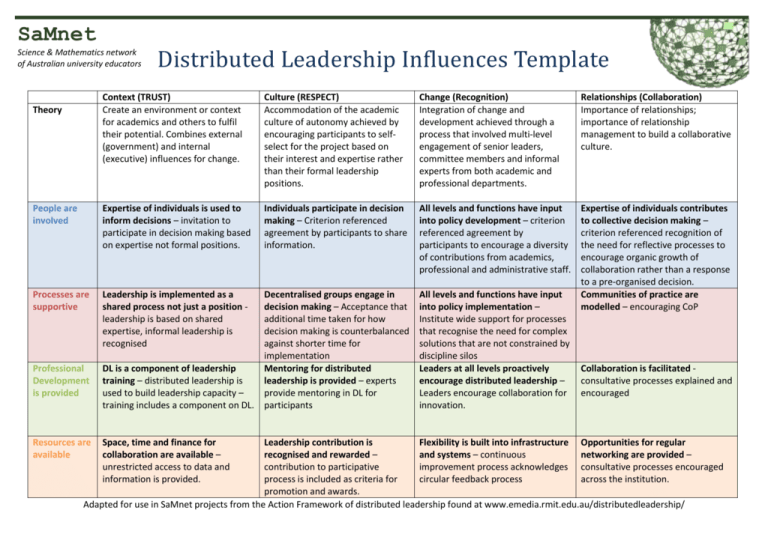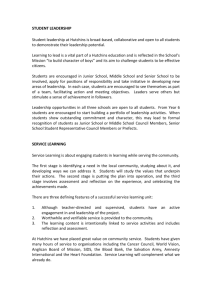Distributed_Leadersh..
advertisement

SaMnet Science & Mathematics network of Australian university educators Distributed Leadership Influences Template Context (TRUST) Create an environment or context for academics and others to fulfil their potential. Combines external (government) and internal (executive) influences for change. Culture (RESPECT) Accommodation of the academic culture of autonomy achieved by encouraging participants to selfselect for the project based on their interest and expertise rather than their formal leadership positions. Change (Recognition) Integration of change and development achieved through a process that involved multi-level engagement of senior leaders, committee members and informal experts from both academic and professional departments. Relationships (Collaboration) Importance of relationships; importance of relationship management to build a collaborative culture. People are involved Expertise of individuals is used to inform decisions – invitation to participate in decision making based on expertise not formal positions. Individuals participate in decision making – Criterion referenced agreement by participants to share information. All levels and functions have input into policy development – criterion referenced agreement by participants to encourage a diversity of contributions from academics, professional and administrative staff. Processes are supportive Leadership is implemented as a shared process not just a position leadership is based on shared expertise, informal leadership is recognised Decentralised groups engage in decision making – Acceptance that additional time taken for how decision making is counterbalanced against shorter time for implementation DL is a component of leadership Mentoring for distributed training – distributed leadership is leadership is provided – experts used to build leadership capacity – provide mentoring in DL for training includes a component on DL. participants All levels and functions have input into policy implementation – Institute wide support for processes that recognise the need for complex solutions that are not constrained by discipline silos Leaders at all levels proactively encourage distributed leadership – Leaders encourage collaboration for innovation. Expertise of individuals contributes to collective decision making – criterion referenced recognition of the need for reflective processes to encourage organic growth of collaboration rather than a response to a pre-organised decision. Communities of practice are modelled – encouraging CoP Theory Professional Development is provided Resources are available Space, time and finance for collaboration are available – unrestricted access to data and information is provided. Collaboration is facilitated consultative processes explained and encouraged Leadership contribution is Flexibility is built into infrastructure Opportunities for regular recognised and rewarded – and systems – continuous networking are provided – contribution to participative improvement process acknowledges consultative processes encouraged process is included as criteria for circular feedback process across the institution. promotion and awards. Adapted for use in SaMnet projects from the Action Framework of distributed leadership found at www.emedia.rmit.edu.au/distributedleadership/ SAMNET INFLUENCES Possible SaMnet Influences (Circle Y or N) “SaMnet has...” Comments on SaMnet Influences Context (TRUST) Culture (RESPECT) Included Project Team Encouraged Team encouraged members from different to consult experts to get opinions academic positions on theory, data or conclusions. Encouraged an Innovative Name of expert: ___________ Academic to take leadership in Assisted the project through the team particular expertise of Critical Notified Dean at start of friend. Name of CF : ___________ project Allowed time for teams to plan Sent project update to and make decisions without dean with leadership SaMnet pressure to begin activities comment on team members Encouraged full participation Accepted the project as a from team members in decision SaMnet project (= Recognition making of leadership) Held SaMnet LeadershipCommunicated to the team Development workshops on a recognition of the team’s leadership attended by team leadership Trained the team indistributed Held Leadershipleadership through conversations Development workshops on with critical friend leadership attended by the Run a workshop attended by team team where scholarly output in Given advice to the team education was linked with to make space and time to promotion criteria meet and work together Encouraged the team to seek recognition for achievements Change (Recognition) Facilitated connections with professional or administrative staff Provided administrative assistance from SaMnet H! Assisted the team in bring about change in practice or policy Encouraged distributed leadership in the team Encouraged others in the institution to support distributed leadership Encouraged reflection on practices Supportedthe teams desire for changes to project implementation decided upon reflection Relationships (Collaboration) Promoted team collaboration Promoted individual team expertise to work together to make decisions Held topic based skypes as communities of practice attended by team Provided networking opportunities to facilitate a Community of Practice Encouraged connections within the institution Encouraged connections outside the institution Held workshops on collaboration attended by team Made a connection with another team in the SaMnet newsletter Regularly communicated with team (HQ) Regularly communicated with team (Critical Friend) Possible Institutional Influences (Circle Y or N) “The Institution has...” Comments on Institutional Influences Context (TRUST) Invited experts to make decisions regardless of formal position Encouraged team members to contribute their expertise to changes in the school Participated in the leadership aspect of the SaMnet project (recognised the leadership of the team) Replied to SaMnet’s advocacy of the team’s leadership? (Dean) Provided professional development on distributed leadership? Provided space for the project to run Allowed project to collect and use data Provided funding for the project INSTITUTIONAL INFLUENCES Culture (RESPECT) Change (Recognition) Enabled the team to access Existing connections with required information to make other departments/areas to decisions assist with group projects (IT, Enabled the team to share other teaching academics, recommendations with institution learning and teaching units) Given time for team decisions Grants available to project to be made by the team not the teams to work with groups eg. individual eLearning, IT Offered training in distributed Existing Cross-discipline leadership learning and teaching links Formal Criteria in place which Learning and Teaching type recognises participation in SaMnet units with an active role. project Shown support publically Formal Criteria in place relating for the project by the to achievement in education administration (head of research school, DVC, Dean) Enabled Team members to Recognised the team’s apply for promotions including work in university publications SaMnet participation as criteria or newsletters Promoted team members using Encouraged reflection (as SaMnet participation as criteria. opposed to output being the focus) Flexibility in deadlines set. Relationships (Collaboration) Looked to develop team members as leaders Encouraged feedback from team members on institutional decisions Organised Communities of Practice for areas related to research in education Organised collaborative events within faculties Mentored team members Systems for regular communication such as skype, other online interaction Physical spaces for meetings and collaborative work in the university Possible Individual/ Team Influences (Circle Y or N) “The team* has...” *or members of the team Comments on Individual/ Team Influences Sought to share ideas in their area of expertise for institutional decisions Sought to share ideas with those in superior roles Seen themselves as leaders in the institution Recognised others who don’t have formal leadership positions as leaders if they show leadership Participated in distributed leadership professional development (at institution or SaMnet Made time to do the SaMnet project in the schedule/programs they are involved in. Sought information that was gathered by others to use in the project or have sought assistance in gathering data INDIVIDUAL/TEAM INFLUENCES Sought access to institutional Connected with data to make decisions and professional staff to assist with recommendations on practices aspects of the project (IT, Awaited input from multiple Admin staff) members of the team in the Connected with academics process of decision making in other disciplines/education Sought input from various nonEncouraged others not in team members on project the project team as informal decisions leaders Participated in mentoring in Encouraged others in the distributed leadership with a project team as informal critical friend leaders Participated in mentoring in Had intentional team distributed leadership at SaMnet meetings to reflect on project workshops progress Used leadership experience Made changes to the with SaMnet as evidence for project plan based on promotion or awards reflection Used leadership experience other than SaMnet as evidence for promotion or awards Made decisions as a team Engaged with Communities of Practice established through SaMnet Engaged with Communities of Practice established through the institution Established their own gatherings to form a Community of Practice Had regular meetings involving most of the team members Often CCd all team members on team emails Followed up on SaMnet recommendation for a connection to another project team Shared information/challenges/results with others in the institution to get feedback General Comments Do the team members see Have the team members felt themselves as leaders? Why is this? empowered to do their work with recognition from the institution or SaMnet? Has there been change or much reflection during the project? Has there been change in the institution as a result of the project? How often has the team collaborated on their work? What is the preferred means of communication? Activities (STRATEGIC): Activity assumes a shared purpose through cycles of change. It is essential that participants in distributed leadership are encouraged to become involved by planning activities following a process that facilitates participants’ engagement in action research through cycles of planning, acting, observing and reflecting. What are the key steps or phases that have been undertaken for this action learning project Key: People are involved - Processes are supportive - Professional Development is provided - Resources are available






